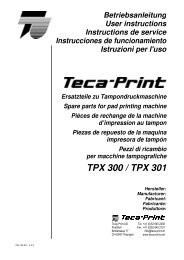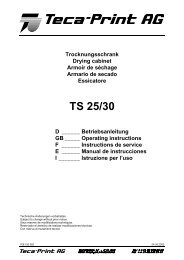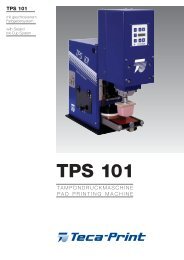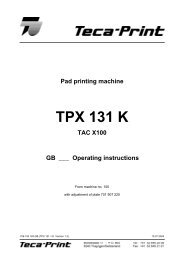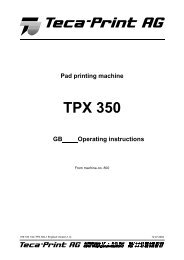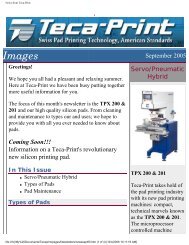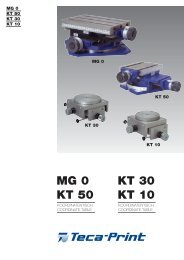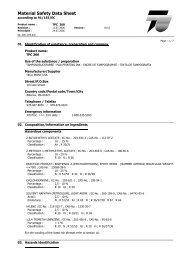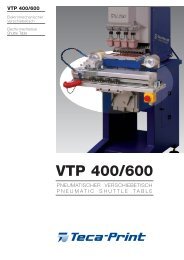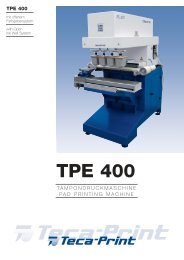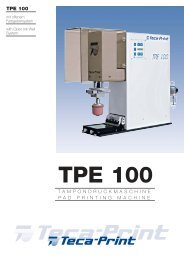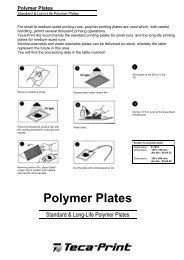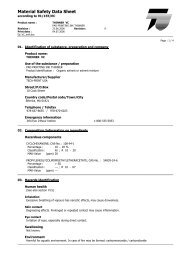Curing Pad - Teca-Print
Curing Pad - Teca-Print
Curing Pad - Teca-Print
You also want an ePaper? Increase the reach of your titles
YUMPU automatically turns print PDFs into web optimized ePapers that Google loves.
<strong>Teca</strong>-<strong>Print</strong> USA Corp. • 10 Cook Street • Billerica, MA • 01821<br />
Phone: 978-667-8655 Fax: 978-670-6023
06.09.2004/Lgg<br />
TPC860_en1.doc<br />
UV - <strong>Curing</strong> <strong>Pad</strong> <strong>Print</strong>ing Ink TPC 860<br />
Application<br />
UV-curing pad printing ink range TPC 860 is a<br />
new system for universal applications. Due to<br />
the high quality UV-curing Epoxy-resins<br />
contained it meets highest demands.<br />
A variety of substrates can be printed with<br />
these pad printing inks. In addition to rigid and<br />
plasticised PVC, pre-treated polyolefines,<br />
polycarbonate and various polystyrene<br />
modifications TPC 860 inks are also suitable<br />
for glass, paper, duroplastics and metal<br />
surfaces.<br />
Due to the different properties of printing<br />
materials, even within the same material<br />
range, printing tests are absolutely necessary.<br />
Properties<br />
Technical Data Sheet<br />
TPC 860, UV - <strong>Curing</strong><br />
<strong>Pad</strong> <strong>Print</strong>ing Ink<br />
Standard Shades<br />
TPC 860/60-HD-NT white, highly opaque<br />
TPC 860/65-NT black<br />
Other shades can be manufactured subject to<br />
our special ink shade regulation.<br />
Process Colour according to European Scale<br />
TPC 860/180-NT yellow<br />
TPC 860/181-NT magenta<br />
TPC 860/182-NT cyan<br />
Mixing System Base Colours<br />
TPC 860/GF-01-NT primrose<br />
TPC 860/GF-02-NT golden yellow<br />
TPC 860/GF-03-NT orange<br />
TPC 860/GF-04-NT scarlet<br />
TPC 860/GF-05-NT magenta<br />
TPC 860/GF-06-NT red<br />
TPC 860/GF-07-NT violet<br />
UV- curing pad printing inks TPC 860 show the<br />
following properties: TPC 860/GF-08-NT blue<br />
-good opacity<br />
TPC 860/GF-09-NT green<br />
-low tendency to yellowing<br />
TPC 860/GF-11-NT white<br />
TPC 860/GF-12-NT black<br />
-good adhesion on different substrates<br />
TPC 860/GF-13 varnish<br />
-high gloss<br />
-adjustable flexibility Adjustment for <strong>Pad</strong> <strong>Print</strong>ing<br />
-very good transfer properties from pad to<br />
substrate<br />
-additional post-curing by heat application is<br />
possible after UV-curing<br />
-shadow free print with good contour<br />
sharpness<br />
Colour Shades<br />
The colour shades of the TPC 860-NT range<br />
show heavy metal free pigmentation and<br />
correspond to EN 71, part 3, safety of toys,<br />
migration of certain elements.<br />
Ink Colour Programme<br />
1/2<br />
1<br />
Prior to processing pad printing inks TPC 860-<br />
NT are adjusted with thinner VD. Viscospatula<br />
time = 6 ...10 sec.<br />
In the event of static discharge on the printing<br />
surface, our Antistatic Paste AP brings a<br />
splash-free printing quality.<br />
Recommended range = 3 … 5 %. More than 5<br />
% results in less opacity.<br />
Liquid anti-static products produce fewer<br />
positive effects.<br />
Processing<br />
The following processing parameter have to be<br />
followed:<br />
Plate:
06.09.2004/Lgg<br />
TPC860_en1.doc<br />
All kinds of clichés can be used, however due<br />
to their better resistance steel plates are<br />
preferred. Criteria for choice of plates are<br />
comparable to those of conventionally drying<br />
pad printing inks.<br />
Plate depths:<br />
Plate with an etching depth of 16...24 µm.<br />
Type and quality of pad:<br />
Processing of TPC 860-NT should be carried<br />
out with Long-Life-<strong>Pad</strong>s with an unworn<br />
surface (hardness 54 Shore-00).<br />
UV-curing<br />
<strong>Pad</strong> printing inks TPC 860 only cure under UVradiation<br />
(approx. 2000mJ/cm²) within a<br />
wavelength of 250- 410 nm.<br />
Then curing can be accelerated by heat<br />
application. The chain-polymerisation caused<br />
by the UV-light will continue at room<br />
temperature.<br />
For difficult substrates we recommend to dry at<br />
100°C for a period of 10 minutes.<br />
Cleaning<br />
For cleaning of stencils and tools our universal<br />
cleaning agent RE can be used.<br />
Packing<br />
TPC 860-NT inks are available in 1 liter cans<br />
(approx. 1.06 qt.).<br />
Shelf Life<br />
For information regarding shelf life please see<br />
tin label.<br />
Marking<br />
Read material safety data sheets prior to<br />
processing.<br />
The material safety data sheets according to<br />
91/155/EWG contain marking in compliance<br />
with the regulation on dangerous working<br />
materials as well as instructions for<br />
precautions when processing, handling and<br />
storing as well as first aid.<br />
2/2<br />
Technical Data Sheet<br />
TPC 860, UV - <strong>Curing</strong><br />
<strong>Pad</strong> <strong>Print</strong>ing Ink<br />
The information given in the material safety<br />
data sheet refers to processing as described in<br />
this technical leaflet.<br />
The statements in our leaflets and safety<br />
data sheets are based on our present<br />
experiences, however they are no<br />
assurance of product properties and do not<br />
justify a contractual legal relationship. They<br />
serve to advise our business associates,<br />
but it is absolutely necessary to make your<br />
own printing tests under local conditions,<br />
with regard to the intended purpose prior<br />
to starting the job. - All former leaflets are<br />
no longer valid. August 2002.
11.11.2004/Lgg<br />
TPC790_en1.doc<br />
UV - <strong>Curing</strong> <strong>Pad</strong> <strong>Print</strong>ing Ink TPC 790<br />
Technical Data Sheet<br />
TPC 790, UV - <strong>Curing</strong><br />
<strong>Pad</strong> <strong>Print</strong>ing Ink<br />
Application Adjustment for <strong>Pad</strong> <strong>Print</strong>ing<br />
TPC 790 is a UV-curing pad printing ink which<br />
was especially developed for ABS material.<br />
However, also SAN, polystyrene, PVC and<br />
other substrates can be printed.<br />
The modified TPC 790 is suitable for<br />
polyamide, also glass-fibre reinforced. This<br />
adjustment will also show adhesion on various<br />
metals. TPC 790 shows a lower degree of<br />
gloss than TPC 780.<br />
Prior to processing pad printing inks TPC 790-<br />
NT are adjusted with 10 … 20 % thinner VD or<br />
VS (quicker). Retarder = VG.<br />
Viscospatula time = 6 ...10 sec.<br />
In the event of static discharge on the printing<br />
surface, our Antistatic Paste AP brings a<br />
splash-free printing quality.<br />
Recommended range = 3 … 5 %. More than 5<br />
% results in less opacity.<br />
Pretests are absolutely necessary! Liquid anti-static products produce fewer<br />
positive effects.<br />
Colour Shades<br />
The colour shades of the TPC 790-NT range<br />
show heavy metal free pigmentation and<br />
correspond to EN 71, part 3, safety of toys,<br />
migration of certain elements.<br />
Ink Colour Programme<br />
Process Colour according to European Scale<br />
TPC 790/180-NT yellow<br />
TPC 790/181-NT magenta<br />
TPC 790/182-NT cyan<br />
Mixing System Base Colours<br />
TPC 790/GF-01-NT primrose<br />
TPC 790/GF-02-NT golden yellow<br />
TPC 790/GF-03-NT orange<br />
TPC 790/GF-04-NT scarlet<br />
TPC 790/GF-05-NT magenta<br />
TPC 790/GF-06-NT red<br />
TPC 790/GF-07-NT violet<br />
TPC 790/GF-08-NT blue<br />
TPC 790/GF-09-NT green<br />
TPC 790/GF-11-NT white<br />
TPC 790/GF-12-NT black<br />
TPC 790/GF-13 varnish<br />
1/2<br />
1<br />
Processing<br />
The following processing parameter have to be<br />
followed:<br />
Plate:<br />
All kinds of clichés can be used, however due<br />
to their better resistance steel plates are<br />
preferred. Criteria for choice of plates are<br />
comparable to those of conventionally drying<br />
pad printing inks.<br />
Plate depths:<br />
Plate with an etching depth of 16...24 µm.<br />
Type and quality of pad:<br />
Processing of TPC 790-NT should be carried<br />
out with AntiStatic-LongLife-<strong>Pad</strong>s with an<br />
unworn surface (hardness 54 Shore-00).<br />
UV-curing<br />
<strong>Pad</strong> printing inks TPC 790 only cure under UVradiation<br />
of suitable wavelength and intensity.<br />
Drying parameter depend on layer thickness,<br />
colour and substrate.<br />
<strong>Curing</strong> energy should be between 500 and<br />
1000 mJ/cm². Maximum chemical and<br />
abrasion resistance will be achieved after a<br />
period of 24 hours.<br />
NOTE: Cured prints are difficult to overprint.<br />
Therefore, there should be no intermediate
11.11.2004/Lgg<br />
TPC790_en1.doc<br />
curing in multi-colour printing. Cure after<br />
printing all layers.<br />
Cleaning<br />
For cleaning of stencils and tools our universal<br />
cleaning agent RE can be used.<br />
Packing<br />
TPC 790-NT inks are available in 1 liter cans<br />
(approx. 1.06 qt.).<br />
Shelf Life<br />
For information regarding shelf life please see<br />
tin label.<br />
Marking<br />
Read material safety data sheets prior to<br />
processing.<br />
The material safety data sheets according to<br />
91/155/EWG contain marking in compliance<br />
with the regulation on dangerous working<br />
materials as well as instructions for<br />
precautions when processing, handling and<br />
storing as well as first aid.<br />
The information given in the material safety<br />
data sheet refers to processing as described in<br />
this technical leaflet.<br />
2/2<br />
Technical Data Sheet<br />
TPC 790, UV - <strong>Curing</strong><br />
<strong>Pad</strong> <strong>Print</strong>ing Ink<br />
The statements in our leaflets and safety<br />
data sheets are based on our present<br />
experiences, however they are no<br />
assurance of product properties and do not<br />
justify a contractual legal relationship. They<br />
serve to advise our business associates,<br />
but it is absolutely necessary to make your<br />
own printing tests under local conditions,<br />
with regard to the intended purpose prior<br />
to starting the job. - All former leaflets are<br />
no longer valid. March 2003 – Version No.3
06.09.2004/Lgg<br />
TPC780_en1.doc<br />
UV - <strong>Curing</strong> <strong>Pad</strong> <strong>Print</strong>ing Ink TPC 780<br />
Application<br />
TPC 780 is a UV-curing pad printing ink which<br />
was especially developed for ABS material.<br />
However, also SAN, polystyrene, PVC and<br />
other substrates can be printed.<br />
Pretests are absolutely necessary!<br />
Colour Shades<br />
The colour shades of the TPC 780-NT range<br />
show heavy metal free pigmentation and<br />
correspond to EN 71, part 3, safety of toys,<br />
migration of certain elements.<br />
Ink Colour Programme<br />
Process Colour according to European Scale<br />
Technical Data Sheet<br />
TPC 780, UV - <strong>Curing</strong><br />
<strong>Pad</strong> <strong>Print</strong>ing Ink<br />
In the event of static discharge on the printing<br />
surface, our Antistatic Paste AP brings a<br />
splash-free printing quality.<br />
Recommended range = 3 … 5 %. More than 5<br />
% results in less opacity.<br />
Liquid anti-static products produce fewer<br />
positive effects.<br />
Processing<br />
The following processing parameter have to be<br />
followed:<br />
Plate:<br />
All kinds of clichés can be used, however due<br />
to their better resistance steel plates are<br />
preferred. Criteria for choice of plates are<br />
comparable to those of conventionally drying<br />
pad printing inks.<br />
Plate depths:<br />
TPC 780/180-NT yellow Plate with an etching depth of 16...24 µm.<br />
TPC 780/181-NT magenta<br />
TPC 780/182-NT cyan Type and quality of pad:<br />
Mixing System Base Colours<br />
TPC 780/GF-01-NT primrose<br />
TPC 780/GF-02-NT golden yellow UV-curing<br />
Processing of TPC 780-NT should be carried<br />
out with AntiStatic-LongLife-<strong>Pad</strong>s with an<br />
unworn surface (hardness 54 Shore-00).<br />
TPC 780/GF-03-NT orange <strong>Pad</strong> printing inks TPC 780 only cure under UV-<br />
TPC 780/GF-04-NT scarlet<br />
TPC 780/GF-05-NT magenta<br />
TPC 780/GF-06-NT red<br />
TPC 780/GF-07-NT violet<br />
radiation of suitable wavelength and intensity.<br />
Drying parameter depend on layer thickness,<br />
colour and substrate.<br />
TPC 780/GF-08-NT blue <strong>Curing</strong> energy should be between 500 and<br />
TPC 780/GF-09-NT green<br />
TPC 780/GF-11-NT white<br />
TPC 780/GF-12-NT black<br />
TPC 780/GF-13 varnish<br />
Adjustment for <strong>Pad</strong> <strong>Print</strong>ing<br />
Prior to processing pad printing inks TPC 780-<br />
NT are adjusted with 10 … 20 % thinner VD or<br />
VS (quicker). Retarder = VG.<br />
Viscospatula time = 6 ...10 sec.<br />
1/2<br />
1<br />
1000 mJ/cm². Maximum chemical and<br />
abrasion resistance will be achieved after a<br />
period of 24 hours.<br />
NOTE: Cured prints are difficult to overprint.<br />
Therefore, there should be no intermediate<br />
curing in multi-colour printing. Cure after<br />
printing all layers.<br />
Cleaning<br />
For cleaning of stencils and tools our universal<br />
cleaning agent RE can be used.
06.09.2004/Lgg<br />
TPC780_en1.doc<br />
Packing<br />
TPC 780-NT inks are available in 1 liter cans<br />
(approx. 1.06 qt.).<br />
Shelf Life<br />
For information regarding shelf life please see<br />
tin label.<br />
Marking<br />
Read material safety data sheets prior to<br />
processing.<br />
The material safety data sheets according to<br />
91/155/EWG contain marking in compliance<br />
with the regulation on dangerous working<br />
materials as well as instructions for<br />
precautions when processing, handling and<br />
storing as well as first aid.<br />
The information given in the material safety<br />
data sheet refers to processing as described in<br />
this technical leaflet.<br />
2/2<br />
Technical Data Sheet<br />
TPC 780, UV - <strong>Curing</strong><br />
<strong>Pad</strong> <strong>Print</strong>ing Ink<br />
The statements in our leaflets and safety<br />
data sheets are based on our present<br />
experiences, however they are no<br />
assurance of product properties and do not<br />
justify a contractual legal relationship. They<br />
serve to advise our business associates,<br />
but it is absolutely necessary to make your<br />
own printing tests under local conditions,<br />
with regard to the intended purpose prior<br />
to starting the job. - All former leaflets are<br />
no longer valid. March 2003 – Version No.3
06.09.2004/Lgg<br />
TPC770_en1.doc<br />
UV - <strong>Curing</strong> <strong>Pad</strong> <strong>Print</strong>ing Ink TPC 770<br />
Application<br />
UV-curing pad printing ink range TPC 770 is<br />
suitable for printing onto rigid and plasticized<br />
PVC, polycarbonate, polyester, polyamide,<br />
duroplastics, coated surfaces and various<br />
polystyrene modifications.<br />
Due to the different properties of printing<br />
materials, even within the same material<br />
range, printing tests are absolutely necessary.<br />
Technical Data Sheet<br />
TPC 770, UV - <strong>Curing</strong><br />
<strong>Pad</strong> <strong>Print</strong>ing Ink<br />
TPC 770/GF-05-NT magenta<br />
TPC 770/GF-06-NT red<br />
TPC 770/GF-07-NT violet<br />
TPC 770/GF-08-NT blue<br />
TPC 770/GF-09-NT green<br />
TPC 770/GF-11-NT white<br />
TPC 770/GF-12-NT black<br />
TPC 770/GF-13 varnish<br />
Adjustment for <strong>Pad</strong> <strong>Print</strong>ing / Auxiliary<br />
agents<br />
Properties <strong>Print</strong>ing consistency is adjusted with 5-15%<br />
thinner VD, VS (quicker) or retarder ZG.<br />
UV- curing pad printing inks TPC 770 show<br />
good printability even if printing speed is high<br />
and the plates used are deeply etched.<br />
Chemical resistance is good. They also show<br />
a very good abrasion resistance.<br />
Colour Shades<br />
The colour shades of the TPC 770-NT range<br />
show heavy metal free pigmentation and<br />
correspond to EN 71, part 3, safety of toys,<br />
migration of certain elements.<br />
Ink Colour Programme<br />
Standard Shades<br />
TPC 770/60-NT white<br />
TPC 770/65-NT black<br />
Process Colour according to European Scale<br />
TPC 770/180-NT yellow<br />
TPC 770/181-NT magenta<br />
TPC 770/182-NT cyan<br />
Mixing System Base Colours<br />
TPC 770/GF-01-NT primrose<br />
TPC 770/GF-02-NT golden yellow<br />
TPC 770/GF-03-NT orange<br />
TPC 770/GF-04-NT scarlet<br />
1/2<br />
1<br />
Viscospatula time = 6 ...10 sec.<br />
In the event of static discharge on the printing<br />
surface, our Antistatic Paste AP brings a<br />
splash-free printing quality.<br />
Recommended range = 3 … 5 %. More than 5<br />
% results in less opacity.<br />
Liquid anti-static products produce fewer<br />
positive effects.<br />
UV-curing<br />
<strong>Pad</strong> printing inks TPC 770 only cure under UVradiation<br />
of suitable wavelength and intensity.<br />
Drying parameter depend on layer thickness,<br />
colour and substrate.<br />
<strong>Curing</strong> energy should be between 500 and<br />
2000 mJ/cm². Further processing and stacking<br />
of the prints can be carried out immediately<br />
after drying, however maximum chemical and<br />
abrasion resistance will only be achieved after<br />
a period of 24 hours.<br />
Processing<br />
The following processing parameter have to be<br />
followed:<br />
Plate:<br />
All kinds of clichés can be used, however due<br />
to their better resistance steel plates are
06.09.2004/Lgg<br />
TPC770_en1.doc<br />
preferred. Criteria for choice of plates are<br />
comparable to those of conventionally drying<br />
pad printing inks.<br />
Plate depths:<br />
Plate with an etching depth of 16...24 µm.<br />
Type and quality of pad:<br />
Processing of TPC 770-NT should be carried<br />
out with AntiStatic-LongLife-<strong>Pad</strong>s with an<br />
unworn surface (hardness 54/64 Shore-00).<br />
UV-curing<br />
<strong>Pad</strong> printing inks TPC 770 only cure under UVradiation<br />
of suitable wavelength and intensity.<br />
Drying parameter depend on layer thickness,<br />
colour and substrate.<br />
<strong>Curing</strong> energy should be between 750 and<br />
2000 mJ/cm². Further processing and stacking<br />
of the prints can be carried out immediately<br />
after drying, however maximum chemical and<br />
abrasion resistance will only be achieved after<br />
a period of 24 hours.<br />
NOTE: Cured prints are difficult to overprint.<br />
Therefore, there should be no intermediate<br />
curing in multi-colour printing. Cure after<br />
printing all layers.<br />
Cleaning<br />
For cleaning of stencils and tools our universal<br />
cleaning agent RE can be used.<br />
Packing<br />
TPC 770-NT inks are available in 1 liter cans<br />
(approx. 1.06 qt.).<br />
Shelf Life<br />
For information regarding shelf life please see<br />
tin label.<br />
Marking<br />
Read material safety data sheets prior to<br />
processing.<br />
The material safety data sheets according to<br />
91/155/EWG contain marking in compliance<br />
with the regulation on dangerous working<br />
2/2<br />
Technical Data Sheet<br />
TPC 770, UV - <strong>Curing</strong><br />
<strong>Pad</strong> <strong>Print</strong>ing Ink<br />
materials as well as instructions for<br />
precautions when processing, handling and<br />
storing as well as first aid.<br />
The information given in the material safety<br />
data sheet refers to processing as described in<br />
this technical leaflet.<br />
The statements in our leaflets and safety<br />
data sheets are based on our present<br />
experiences, however they are no<br />
assurance of product properties and do not<br />
justify a contractual legal relationship. They<br />
serve to advise our business associates,<br />
but it is absolutely necessary to make your<br />
own printing tests under local conditions,<br />
with regard to the intended purpose prior<br />
to starting the job. - All former leaflets are<br />
no longer valid.<br />
April 2000
06.09.2004/Lgg<br />
TPC760_en1.doc<br />
UV - <strong>Curing</strong> <strong>Pad</strong> <strong>Print</strong>ing Ink TPC 760<br />
Application<br />
For printing onto pre-treated polypropylene.<br />
Due to various degrees of polymerisation as<br />
well as contents and fillers the substrate<br />
polypropylene shows an undefined printability.<br />
Therefore printing tests in production<br />
conditions are absolutely necessary.<br />
Colour Shades<br />
The colour shades of the TPC 760-NT range<br />
show heavy metal free pigmentation and<br />
correspond to EN 71, part 3, safety of toys,<br />
migration of certain elements.<br />
Ink Colour Programme<br />
Process Colour according to European Scale<br />
Technical Data Sheet<br />
TPC 760, UV - <strong>Curing</strong><br />
<strong>Pad</strong> <strong>Print</strong>ing Ink<br />
In the event of static discharge on the printing<br />
surface, our Antistatic Paste AP brings a<br />
splash-free printing quality.<br />
Recommended range = 3 … 5 %. More than 5<br />
% results in less opacity.<br />
Liquid anti-static products produce fewer<br />
positive effects.<br />
Processing<br />
The following processing parameter have to be<br />
followed:<br />
Plate:<br />
All kinds of clichés can be used, however due<br />
to their better resistance steel plates are<br />
preferred. Criteria for choice of plates are<br />
comparable to those of conventionally drying<br />
pad printing inks.<br />
Plate depths:<br />
TPC 760/180-NT yellow Plate with an etching depth of 16...24 µm.<br />
TPC 760/181-NT magenta<br />
TPC 760/182-NT cyan Type and quality of pad:<br />
Mixing System Base Colours<br />
TPC 760/GF-01-NT primrose<br />
TPC 760/GF-02-NT golden yellow UV-curing<br />
Processing of TPC 760-NT should be carried<br />
out with AntiStatic-LongLife-<strong>Pad</strong>s with an<br />
unworn surface (hardness 54 Shore-00).<br />
TPC 760/GF-03-NT orange <strong>Pad</strong> printing inks TPC 760 only cure under UV-<br />
TPC 760/GF-04-NT scarlet<br />
TPC 760/GF-05-NT magenta<br />
TPC 760/GF-06-NT red<br />
TPC 760/GF-07-NT violet<br />
radiation of suitable wavelength and intensity.<br />
Drying parameter depend on layer thickness,<br />
colour and substrate.<br />
TPC 760/GF-08-NT blue <strong>Curing</strong> energy should be between 750 and<br />
TPC 760/GF-09-NT green<br />
TPC 760/GF-11-NT white<br />
TPC 760/GF-12-NT black<br />
TPC 760/GF-13 varnish<br />
Adjustment for <strong>Pad</strong> <strong>Print</strong>ing<br />
Prior to processing pad printing inks TPC 760-<br />
NT are adjusted with 10 … 20 % thinner VS or<br />
VT (quicker). Retarder = VG.<br />
Viscospatula time = 6 ...10 sec.<br />
1/2<br />
1<br />
1500 mJ/cm². Maximum chemical and<br />
abrasion resistance will be achieved after a<br />
period of 24 hours.<br />
NOTE: Cured prints are difficult to overprint.<br />
Therefore, there should be no intermediate<br />
curing in multi-colour printing. Cure after<br />
printing all layers.<br />
Cleaning<br />
For cleaning of stencils and tools our universal<br />
cleaning agent RE can be used.
06.09.2004/Lgg<br />
TPC760_en1.doc<br />
Packing<br />
TPC 760-NT inks are available in 1 liter cans<br />
(approx. 1.06 qt.).<br />
Shelf Life<br />
For information regarding shelf life please see<br />
tin label.<br />
Marking<br />
Read material safety data sheets prior to<br />
processing.<br />
The material safety data sheets according to<br />
91/155/EWG contain marking in compliance<br />
with the regulation on dangerous working<br />
materials as well as instructions for<br />
precautions when processing, handling and<br />
storing as well as first aid.<br />
The information given in the material safety<br />
data sheet refers to processing as described in<br />
this technical leaflet.<br />
2/2<br />
Technical Data Sheet<br />
TPC 760, UV - <strong>Curing</strong><br />
<strong>Pad</strong> <strong>Print</strong>ing Ink<br />
The statements in our leaflets and safety<br />
data sheets are based on our present<br />
experiences, however they are no<br />
assurance of product properties and do not<br />
justify a contractual legal relationship. They<br />
serve to advise our business associates,<br />
but it is absolutely necessary to make your<br />
own printing tests under local conditions,<br />
with regard to the intended purpose prior<br />
to starting the job. - All former leaflets are<br />
no longer valid. November 2001 – Version<br />
No.1
06.09.2004/Lgg<br />
TPC750_en1.doc<br />
Base<br />
Technical Data Sheet<br />
TPC 750, UV - <strong>Curing</strong><br />
<strong>Pad</strong> <strong>Print</strong>ing Ink<br />
UV - <strong>Curing</strong> Protective Varnishes TPC 750<br />
Based on pre-polymerised acrylates added<br />
with inorganic extenders. Thinner VT<br />
Thinner VS<br />
Retarder VG<br />
Application<br />
Ink type TPC 750 has been developed as<br />
protection varnish for e.g. key pads, etc. is<br />
suitable for printing onto ABS, PC, PMMA and<br />
other plastics.<br />
Due to the different properties of the printing<br />
materials, even within the same material<br />
range, printing tests are absolutely necessary.<br />
<strong>Print</strong>ing consistency is adjusted with 10-15%<br />
thinner or retarder:<br />
In the event of static discharge on the printing<br />
surface, our Antistatic Paste AP brings a<br />
splash-free printing quality.<br />
Recommended range = 3 … 5 %. More than 5<br />
% results in less opacity.<br />
Liquid anti-static products produce fewer<br />
positive effects.<br />
UV-curing<br />
Properties Protective varnishes TPC 750 / 70/00 and TPC<br />
UV- curing pad printing varnishes TPC 750<br />
show good printability and chemical<br />
resistance. They also show a very good<br />
abrasion resistance.<br />
There are two versions available:<br />
750 / 70/00-MT only cure and polymerise to a<br />
stable, resistant ink film under application of<br />
UV-radiation within a wave-length between<br />
250 … 410 nm.<br />
<strong>Curing</strong>-parameters depend on the applied<br />
layer thickness, surface properties and<br />
temperature.<br />
TPC 750/70-01-MT matt<br />
TPC 750/70-02-NT glossy <strong>Curing</strong> energy should be between 500 and<br />
1500 mJ/cm². Further processing and stacking<br />
Auxiliary agents<br />
UV-curing pad printing varnishes TPC 750/70-<br />
00 and TPC 750/70-00-MT come in a ready-toprint<br />
consistency. If additional modification<br />
should be required for special reasons (e.g.<br />
bad drying or curing) the following universal<br />
additives are available for these UV-curing<br />
varnishes.<br />
TPC 750/UV-A – sensitiser addition up to 2% Radiator<br />
TPC 750/UV-V – thinner addition up to 5%<br />
If possible the use of additives should be<br />
avoided as improper use, especially overdosage,<br />
could result in a negative change of<br />
the original product properties.<br />
1/2<br />
1<br />
of the prints can be carried out immediately<br />
after drying, however maximum chemical and<br />
abrasion resistance will only be achieved after<br />
a period of 24 hours.<br />
At room temperature drying speed will be<br />
about 3 m/min with 2x80 W/cm radiators.<br />
This corresponds to an energy value of<br />
approx. 2000 mJ/cm².<br />
High pressure mercury lamps with an<br />
efficiency of 80–120 W/cm are used to<br />
produce the required UV-radiation. Their<br />
emission spectrum is approx. 250-410 nm with<br />
maximum values at certain wavelengths.
06.09.2004/Lgg<br />
TPC750_en1.doc<br />
The main problem with the radiators is the fact<br />
that the emitted spectrum does not always<br />
correspond to the absorption spectrum of the<br />
UV-curing pad printing inks and thus affects<br />
the curing speed. (Pretests in reference to UVcuring<br />
are absolutely necessary).<br />
Processing<br />
The following processing parameter have to be<br />
followed:<br />
Plate:<br />
All kinds of clichés can be used, however due<br />
to their better resistance steel plates are<br />
preferred. Criteria for choice of plates are<br />
comparable to those of conventionally drying<br />
pad printing inks.<br />
Plate depths:<br />
Plate with an etching depth of 16...22 µm.<br />
Type and quality of pad:<br />
Processing of TPC 750 should be carried out<br />
with Anti-Static-Long-Life-<strong>Pad</strong>s with an unworn<br />
surface (hardness 54 Shore-00).<br />
Cleaning<br />
For cleaning of stencils and tools our universal<br />
cleaning agent RE can be used.<br />
Packing<br />
TPC 750 inks are available in 1 liter cans<br />
(approx. 1.06 qt.).<br />
Shelf Life<br />
For information regarding shelf life please see<br />
tin label.<br />
Marking<br />
Read material safety data sheets prior to<br />
processing.<br />
The material safety data sheets according to<br />
91/155/EWG contain marking in compliance<br />
with the regulation on dangerous working<br />
materials as well as instructions for<br />
2/2<br />
Technical Data Sheet<br />
TPC 750, UV - <strong>Curing</strong><br />
<strong>Pad</strong> <strong>Print</strong>ing Ink<br />
precautions when processing, handling and<br />
storing as well as first aid.<br />
The information given in the material safety<br />
data sheet refers to processing as described in<br />
this technical leaflet.<br />
The statements in our leaflets and safety<br />
data sheets are based on our present<br />
experiences, however they are no<br />
assurance of product properties and do not<br />
justify a contractual legal relationship. They<br />
serve to advise our business associates,<br />
but it is absolutely necessary to make your<br />
own printing tests under local conditions,<br />
with regard to the intended purpose prior<br />
to starting the job. - All former leaflets are<br />
no longer valid.<br />
April 2000
System > UV - Ink. UV - Ink. UV - Ink. UV - Ink. UV - Ink. UV - Ink.<br />
Ink ref. > TPC 750 TPC 760 TPC 770 TPC 780 TPC 790 TPC 860<br />
Puv mJ/cm²> 500 ... 1000 750 ... 1500 500 ... 2000 500 ... 1000 500 ... 1000 2000<br />
SUBSTRATE ¬ Specials > Varnish PP - Ink versatile versatile<br />
Polyolefine<br />
Groupe C<br />
pretreated polyethylene PE (+) o + ++<br />
pretreated polypropylene PP +++ + ++ ++<br />
Thermoplasts<br />
Styrene PS / SB +++ o +++ ++ ++<br />
Styrene-polymerisate ABS +++ ++ o +++ +++ ++<br />
" SAN ++ o +++ +++ ++<br />
" ASA ++ part. + ++ ++ ++<br />
Linear Polyester PET-A, E, P ++ + ++<br />
PET-G ++ ++ ++<br />
Polyvinylchloride PVC hard +++ part. + +++ +++ ++<br />
PVC soft +++ o o ++<br />
Polyacrylate Compounds PAN<br />
Polymethylmethacrylate PMMA +++ pretr. ++ + o / ++ o / ++<br />
Polymethacrylate Comp. AMMA,MBS o / ++ o / ++<br />
Polybutylenterphthalate PBTP pretr. + o + / ++<br />
Polycarbonate PC +++ ++ ++ +++ +++ ++<br />
Polyamide PA pretr. + o +++ / ++<br />
Polyurethane PUR<br />
Cellulose Acetate CA<br />
Cellulose Acetobutyrate CAB<br />
Polyoxide<br />
Polyoxymethylene POM / POM-C o o o<br />
Thermosets<br />
Thermosets (general) ++ ++<br />
Phenoplasts MPF / PPO ++<br />
Aminoplasts ++<br />
Ferrous Metals<br />
stainless steel V2A, V4A + +<br />
steel / iron Fe ++ ++ ++<br />
Non-ferrous Metals<br />
Alu, oxidised/brushed Al ++ ++ ++<br />
plated chrome Cr o o ++<br />
copper Cu ++ ++<br />
brass MS ++ ++<br />
nickel / plated nickel Ni +<br />
tin / plated tin Sn + +<br />
zinc / plated zinc Zn<br />
Lacquered Surfaces<br />
1-component lacquer ++ + +<br />
2-component lacquer ++<br />
UV-lacquer ( CD 's ) + +<br />
Powder lacquer ++<br />
Other Materials<br />
glass, ceramics part. enamelled o ++<br />
uncoated wood ++<br />
paper / cardboard ++<br />
keyboards/golfballs acc. to surface +++<br />
Elastomers<br />
untreated rubber rubber<br />
Thermoplastic elastomers misc. TPE part. + part. ++<br />
Please read the technical data sheets on the respective pad printing inks and additives.<br />
All information is based on laboratory tests in conjunction with practical experience and daily usage.<br />
UV-<strong>Pad</strong> <strong>Print</strong>ing Inks Adhesion onto Substrates 11.2004 / Lgg - Page 1/3



